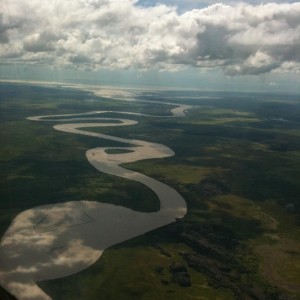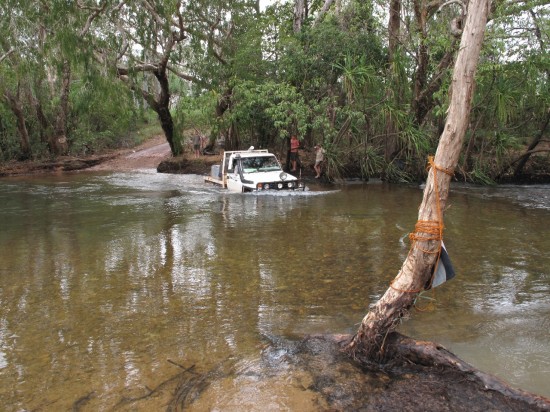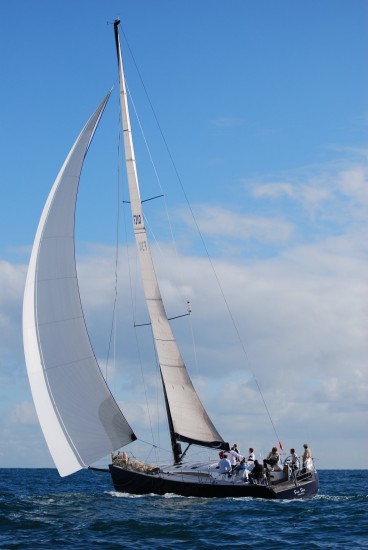Raw, natural beauty abounds in Australia, but there are places in north-east Arnhem Land which must have been moulded by the hands of a primal god. The 650km flight east from Darwin to the town of Nhulunbuy on the Gove Peninsula takes little more than an hour, but it’s a world away.
Passing over Kakadu National Park and Oenpelli, the green-edged snakes of the East Alligator and Mann Rivers twist and uncoil across the dry, red landscape and Arnhem Land unfolds east to the horizon.
Occasional pillars of smoke billow up through the blue sky, made milky by the humid air. Fire is a tool the people of Arnhem Land have used for thousands of years and the smoke from a burn-off covering hundreds of square kilometres is enough to seed passing clouds and produce rain.
It is the Dry Season, the time of, Dharratharra, when the south and south-east winds cut across the land and sea, telling the people it is time to collect mud crabs and turtle eggs.
Arnhem Land isn’t so much a place as an experience. It is an elemental land, governed by earth, wind, fire and water – a mostly untouched wilderness of over 94,000 sq km where it’s often easier to bump into a crocodile than another human being.
Less than 40,000 people live in this wild kingdom about the size of the Australian state of Victoria, and most of them are the owners of this land, the Yolngu or “people”. The rest are Balanda, “European or white people” – mining and government staff, contractors, small business operators and some tourists – temporary visitors in a timeless place.
And Nhulunbuy is little more than an outpost in this vast nature’s keep, perched on the edge of the Gove Peninsula, where the Gulf of Carpentaria meets the Arafura Sea.
The town, with a population of about 4,000, was built in the early 70s as a life-support system for Nabalco’s huge bauxite mine. It has everything to attract jaded miners, and more – from the olympic-sized public swimming pool, golf, flying, surf, tennis, lawn bowls and squash clubs to the well manicured lawns and suburban streets alive with lush vegetation, Bougainvillea, Frangipanni, Banyan Trees and Carpentaria, Traveller and Coconut Palms.
Nabalco employs around 750 people and its mining operations and associated alumina plant, located 15km from Nhulunbuy on the 100sq km natural harbour of Melville Bay, is one of the largest bauxite mines in Australia.
With around 600 single men living in the town, it had all the makings of a rough diamond in the early years, and what went on in the “Animal Bar” is the stuff of local legend. But times change, and some of those rough edges have been smoothed to encourage tourism. The local supermarkets are well stocked with the necessities of modern life, provisioned by the weekly Perkins Shipping barge from Darwin, and for more discerning tastes, fresh fruit and veg is flown in from Cairns, along with such delights as King Island beef.
There is no road haulage into Nhulunbuy, with the only overland link to the outside world provided by the 700km-long Central Arnhem Rd or “Katherine Track”, which cuts through rivers and flood plains to the Stuart Hwy, 60km south of Katherine, and which is often impassable in The Wet.
The living in Nhulunbuy is not cheap, but high wages seem to compensate – there’s a late-model four-wheel-drive in many driveways and a “tinnie” or larger fishing boat on the front lawn. But nothing in this place is ordinary or suburban. Players on the nine-hole golf course are issued with 20 extra balls to discourage them from thrashing through the undergrowth on the banks of the nearby town lagoon, Gaynggaru. Bumping into a saltwater crocodile might put them off their game.
And early morning joggers keep a wary eye for water buffalo that occasionally wander through the town, oblivious to the fact that the land has been leased to Balanda miners.
Yachties from all over the world find their place in the sun at the Gove Yacht Club at Gove Harbour in Melville Bay. Gove is a final provisioning and repair stop for international yachties before heading to waters around the Gulf of Carpentaria, Indonesia, Papua New Guinea and points further north.
Every year in June, the club and its lush gardens which front the harbor were awash with high spirits and alive with sea banter.
More than 40 yachts from 9m to 22m lay at anchor on the tranquil waters, ready to take part in the annual Over The Top race, a 500 nautical mile 12-day Cruise in Company to Darwin along stunning coastline, linking with the Darwin to Ambon race.
Surrounded by thousands of square kilometers of monsoon forests, bushland, wetlands, estuaries, islands and rivers and with daily temperatures around 30C all year, living an outdoors lifestyle is easy and dining under the stars of a tropical night is the norm.
Continues in:
Arnhem Land Part 2 – Fishing The Wild Coast
Arnhem Land Part 3 – White Man Dreaming
Arnhem Land Part 4 – Ancient Bloodline
Photo Credits
Salt Water Crocodile – Tourism NT
Arnhem Land Aerial View – Credit Pending
Darwin To Ambon Race – From The Darwin to Ambon Yacht Race & Rally Facebook Page
Gove Airport Terminal – by Dustin M. Ramsey
Crossing the Goyder River – By eyeweed on Flickr – Some Rights Reserved








[…] Arnhem Land Part 1 – Into A Primal Landscape […]